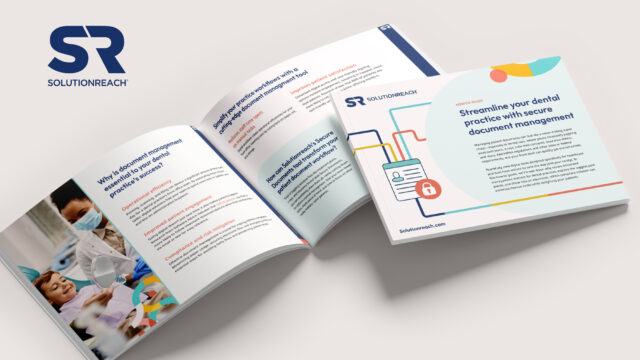Transitioning from stacks of paper documents to a secure digital document management system can feel overwhelming. But let’s face it—the world is moving fast, and so should your practice. A well-planned digital transformation strategy can simplify your business processes, making operations more efficient and improving patient care.
Ready to ditch the clutter of file cabinets for streamlined patient document workflows and a healthier bottom line? Let’s dive into the questions that will guide you toward a successful digital transformation focused on private patient digital document management.
Why make the switch to digital document management?
Tired of sifting through paper forms and cramped storage rooms? Moving to digital document management solutions isn’t just about freeing up physical space; it’s about boosting efficiency, and patient experience, and satisfaction.
- According to a 2023 report, the global Healthcare Document Management Systems market is projected to reach $1.1 billion by 2027 (up from $0.6 billion in 2022), reflecting a growing need for secure, streamlined document handling.
- The American Dental Association (ADA) underscores how digitizing your practice can help reduce overhead, enhance compliance, and improve patient communication.
By implementing a document management software or tools, your practice can securely store, manage, and access documents—like private patients’ treatment plans and consent forms—without the headaches of rummaging through a paper trail.
What are digital document management’s key compliance and workflow benefits?
A robust digital document management solution does more than just digitize forms; it transforms the way you operate by improving business process management and minimizing manual processes. Here’s how:
Enhanced compliance
Automated reminders and required data fields help ensure that vital information is captured, reducing the risk of missed signatures or incomplete documents.
Streamlined workflow
From scheduling and patient check-in to automated billing, digitized documents keep your practice running smoothly—no more hunting down lost forms.
Faster patient communication
Need a patient to sign a treatment plan or waiver? Send it securely via email or portal. Many platforms even support digital signatures, eliminating the need for in-office paperwork.
How do you tackle staff training and buy-in?
Going digital might sound high-tech, but it’s easier than you think—especially if your team is on board:
- Hands-on training: Offer workshops where staff can explore the new system in a safe “sandbox” environment.
- Role-playing exercises: Simulate real-world tasks (e.g., scanning an ID, retrieving an electronic document, sending a digital form for signature) to boost confidence.
- Celebrate successes: Whether it’s mastering a feature or hitting a milestone in document conversion, public praise can ease tech anxieties and keep morale high.
Which steps can streamline the transition to digital?
Assess Your Current Processes
Identify the pain points in your paper-heavy workflow. Is it intake forms, insurance waivers, or consent documents? Pinpoint where digital solutions will deliver the biggest impact.
Choose the Right Document Management System
Not all document management tools are created equal. Look for secure sharing features, automated workflows, and integrations with your practice management software.
Plan Your Timeline
Outline key dates for scanning existing business documents, training your team, and rolling out the system. Go step by step rather than rushing everything at once.
Migrate Data Methodically
Transfer files in batches, verifying accuracy at each stage. You don’t want essential patient records going missing in the shuffle.
Train and Communicate
Provide regular updates, offer user guides, and share best practices. Make sure the staff knows where to turn if questions come up.
Go Live and Monitor
Officially switch on a day when patient volume is manageable. Monitor performance and gather feedback to refine your workflows.
How do you protect data security and PHI to facilitate secure sharing?
Digitizing patient information means taking on extra responsibility for privacy and security—especially regarding Protected Health Information (PHI):
- Encryption and secure access: Look for systems that encrypt data both at rest and in transit. Role-based access ensures that staff only see what they need.
- Regular backups: Maintain offsite backups to safeguard against hardware failures or cyberattacks.
- Audit trails: A digital footprint keeps track of who accessed which documents and when.
- Cybersecurity measures: According to IBM’s Cost of a Data Breach Report, healthcare data breaches remain the costliest of any industry, averaging $10.93 million per incident.
A specialized patient document management tool also lets you securely track documents and share treatment plans, prescriptions, waivers, statements, and other private documents with patients. Many platforms support self-service features such as digital signatures, making it easy for patients to sign forms remotely and cutting down on unnecessary office visits and paperwork.
How will going digital improve your revenue cycle management?
Absolutely. While digital document management isn’t just about billing, it can play a significant role in improving financial operations:
- Faster claims processing: Instant access to patient documentation (e.g., insurance cards, signed waivers) reduces delays in submitting claims.
- Reduced denials: Accurate records and completed forms minimize the odds of claim rejections due to missing data.
- Streamlined billing and collections: Integrated digital statements and payment portals simplify the payment process, enhancing your cash flow.
The Healthcare Financial Management Association (HFMA) notes that streamlined document management can significantly cut administrative overhead and speed up reimbursement.
Are you ready to make the move?
Transitioning from paper files to secure digital document management isn’t just a tech upgrade—it’s a chance to redefine how your practice operates. By choosing the right tools, training your team, and fortifying your data management strategies, you’ll discover new levels of efficiency and compliance. Plus, patients will love the convenience of remote signatures and file sharing for their treatment documents.
Ready to say goodbye to paper jams and hello to streamlined patient care? Start by evaluating where you’ll see the biggest impact—from intake forms to billing. Once your digital transformation initiatives are in place and your team is comfortable, you’ll wonder how you ever managed all those paper piles in the first place!

To learn more about how a secure documents tool can help you transition your manual paper processes into a more efficient and secure digital process, check out the guide, “Streamline Your Dental Practice with Secure Document Management: A How-To Guide.”
Download Guide


